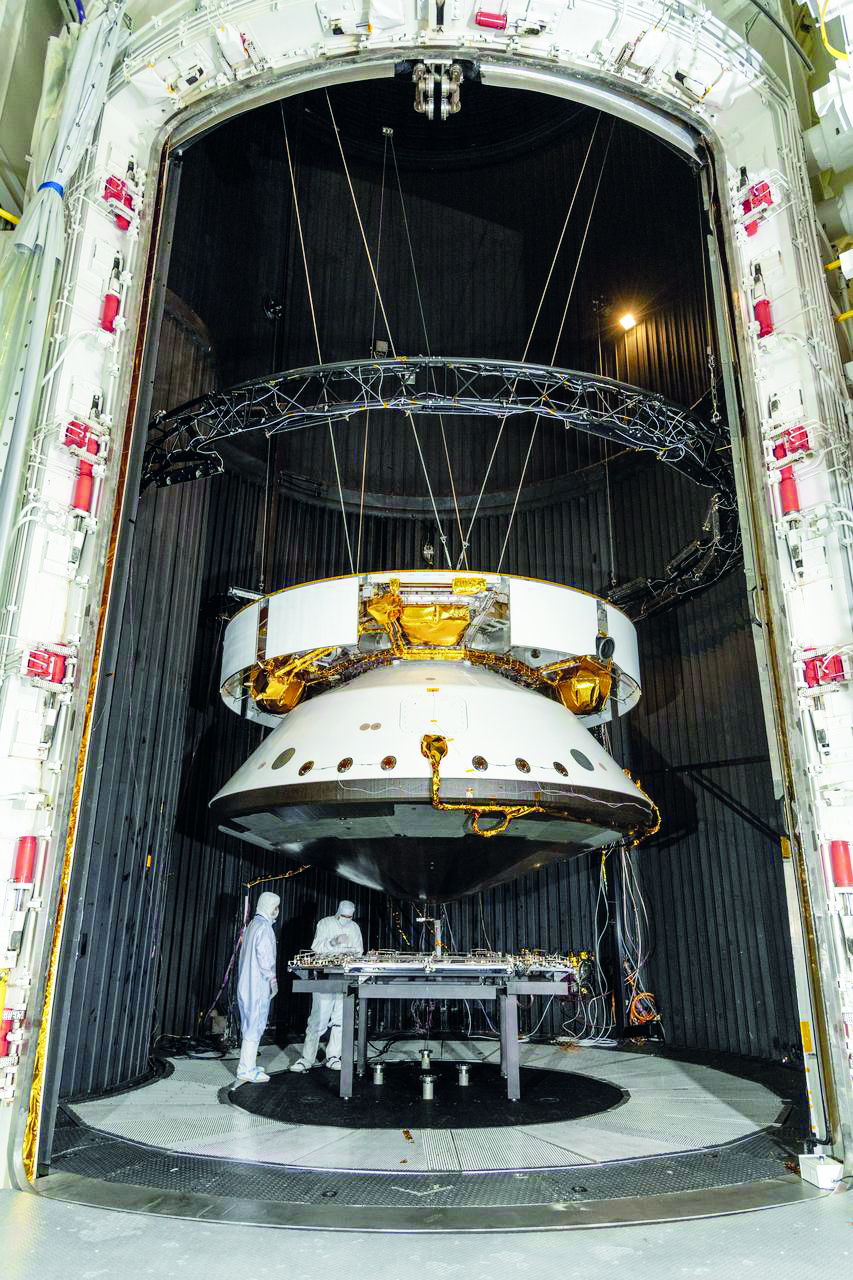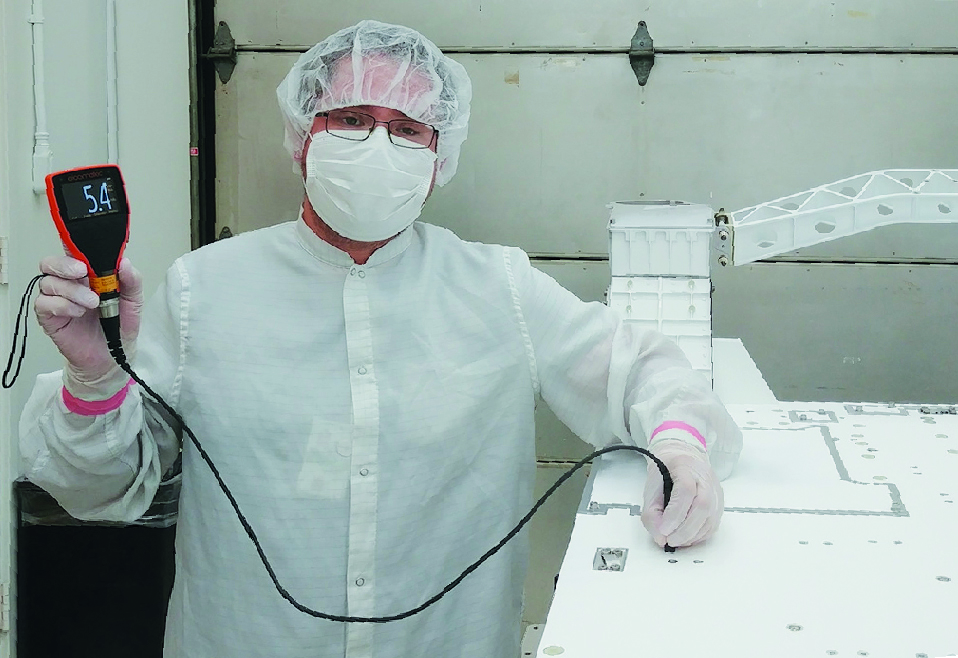In this article, we take a closer look at the characteristics of paints for space applications and at how they are applied, taking as an example the paintwork of Perseverance, the space rover of NASA's Mars 2020 mission.
Painting an object does not only serve to embellish it, but also to protect it from its environment – which, in the absence of an adequate coating, would eventually deteriorate and permanently compromise it. Clearly, this is all the more true for any vehicles and equipment intended to travel and stay in space, where atmospheric conditions can be even more extreme than on Earth (e.g. exposure to infrared and ultraviolet radiation from the Sun or risk of static build-up).
So, how do NASA and other space agencies guarantee the protection and full operation of their space rovers? In this article, we take a closer look at the characteristics that paints for space applications must possess and at their application process, taking as an example the paintwork of Perseverance, the space rover of NASA's Mars 2020 mission in charge of searching for signs of ancient life and collecting rock samples on the Red Planet.
Effects of the space environment on surfaces
In order to effectively withstand the elements, surface coatings applied to space rovers must guarantee comprehensive protection against a number of potential challenges. As well as withstanding temperature cycling, humidity, salt spray environments, and abrasive wear – all these specifications are also required of paints for “terrestrial” applications – coatings for space applications must also meet some special requirements. In fact, in addition to prolonged exposure to vacuum and damage caused by the impact of micrometeorites, the space environment is also characterised by increased exposure to radiation, build-up of static charges, and variable thermal exposure.
For instance, one of the most common problems observed during the first space missions is cold welding, a process that is triggered in space even in the absence of heat and that causes metals in contact with each other to melt in a vacuum. European laboratories refer to it as “adhesion”, “attachment”, or “sticktion”. Cold welding between two contact surfaces can occur under impact or rubbing conditions. Indeed, impacts can degrade surface layers, be they natural oxides, chemical conversion films, or coatings, which greatly increases the tendency of such contact surfaces to “cold weld” to one another.
In this case, specific coatings are required to reduce contact adhesion and avoid cold welding.
Another effect closely related to cold welding is fretting. Vibrations occurring during launch or during the movement of antennas in space, for instance, can generate small oscillatory movements in contact surfaces, which are referred to as “fretting”. These can cause surface destruction and, again, lead to cold welding effects. A documented example of failure due to cold welding caused by fretting occurred on the Galileo spacecraft in 1991. The ribs of its umbrella-shaped High Gain Antenna (HGA), blocked for launch, never fully opened. Investigations showed that rubbing during transport and take-off had triggered the cold welding process on their surfaces while in launch position.
Solar photons can also degrade metal surfaces. UV radiation is often responsible for modifying the microstructure of aluminium alloys, resulting in negative consequences such as the reduction of their tensile strength.
Finally, materials in space applications can suffer severe thermal shocks, both during launch and due to the highly variable temperatures endured in orbit.
 Engineers prepare the Perseverance space rover for a thermal vacuum (TVAC) test in the Space Simulator Facility at NASA's Jet Propulsion Laboratory in Pasadena, California. © NASA/JPL-Caltech
Engineers prepare the Perseverance space rover for a thermal vacuum (TVAC) test in the Space Simulator Facility at NASA's Jet Propulsion Laboratory in Pasadena, California. © NASA/JPL-CaltechProperties of paints intended for space applications
In order to cope with all the potential problems mentioned so far and, therefore, to ensure proper functioning of vehicles and equipment, paints used in space must combine several characteristics.
In general, they should guarantee a high degree of stability and adhesion
in order to withstand the extreme conditions found in space. They should provide excellent thermal shock resistance and proper insulation. They should also be solar reflective and low absorption products, in order to reflect solar radiation and thus reduce degradation caused by solar photons, as well as limiting the temperatures reached by the materials.
Finally, they should ensure very low pore outgassing and be environmentally friendly (i.e. with a low VOC content and free of toxic substances or heavy metals).
The painting process of a space rover
Now that we know the characteristics required of paints intended for use in space, let us see exactly how they are applied. We will take the example of Perseverance, the NASA rover that left on 30 July 2020 and landed on Mars on 18 February 2021 to search for signs of ancient life and collect samples of rock and regolith (broken rock and soil) for a possible return to Earth.
The manufacturing and coating of six-wheel, SUV-size Perseverance rover called for several steps and a much longer lead time than the painting of “terrestrial” vehicles.
Assembly and preliminary work
In mid-April 2018, more than twenty pieces of aluminium 7050 and 7075 intended for the main structure of the rover’s body were placed in a clean room at NASA’s Jet Propulsion Laboratory, along with about a hundred smaller secondary components. Over the next four and a half months, the engineers and technicians of the Mars 2020 mission planned, measured, examined, checked, drilled, and fixed all parts until the rover’s chassis was built. 610 rivets, 730 washers, 644 nuts, and 964 fasteners were needed, which required well over 1000 holes, all drilled by hand.
At the end of 5000 hours of assembly, the chassis was masked in preparation to the coating process, as some of its surface areas had not to be painted. These were points where electrical boxes had to be bolted and wiring carried out and attachment points for hypersensitive scientific instruments that require bare metal surfaces in order to function optimally. This is why the technicians masked all the parts that were not to be painted. Such 500-hour operation called for more than 600 pieces of masking tape in all shapes and sizes (some smaller than a coin), which were applied by hand and smoothed to prevent the formation of bubbles; 135 temporary sheet metal stencils were also applied on larger areas that required a more rigid cover.
The Perseverance chassis, masked with tape and metal covers and protected with a sterile anti-static casing, was taken to the paint shop on 6 August 2018.
Coating and curing
After removing the anti-static casing and inspecting the rover, the technicians prepared its surface by sanding to ensure better paint adhesion. With the aim of preventing corrosion and oxidation, the rule is that, once started, six hours in total are allowed to complete the surface treatment process – which in this case involved sanding, priming, and coating.
Due to the size of the vehicle, three people tackled the application in stages. The upper deck was coated first and left to dry for a day. Then, the technicians proceeded to treat the body’s sides. After a one-day break, the front and back of the rover were painted. Despite the distribution of work, the sandblasting and meticulous cleaning had already taken over two of the six hours available.
For paint application, the operators used guns with the same settings and operated at the same distance while moving at the same speed.
Of course, the primer and top coat used on Perseverance passed rigorous tests to withstand shocks, vibrations, UV rays, and even the Martian cold, all without releasing organic compounds and other materials that could affect the mission’s scientific experiments.
Less than five hours later, the three-coat application was completed, forming a layer with a thickness between 4 and 6 thousandths of an inch.
 JPL mechanical technician Eddie Castro uses a paint meter to measure the paint thickness on the Mars 2020 rover chassis. The reading on the meter indicates a thickness of 5.4 thousandths of an inch. © NASA/JPL-Caltech
JPL mechanical technician Eddie Castro uses a paint meter to measure the paint thickness on the Mars 2020 rover chassis. The reading on the meter indicates a thickness of 5.4 thousandths of an inch. © NASA/JPL-CaltechOn 14 August, the Perseverance body was again wrapped in an anti-static casing and transported to a vacuum chamber, where it was cured at 110 °C under vacuum for three days. This process does not only harden the paint, but it literally bakes any contaminants in the coating that could degas during the flight: as Mars 2020 is an astrobiological mission, it is crucial that the samples taken from Mars are not contaminated.
On Monday, 20 August, the chassis left the oven and underwent a few further inspections and finishing touches, finally ready to leave for Mars.
Learn more and stay up-to-date with the latest news from the surface treatment industry by subscribing to the free digital version of our technical magazines.